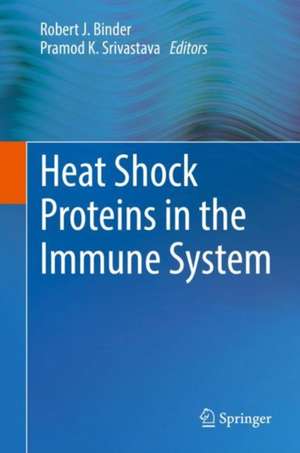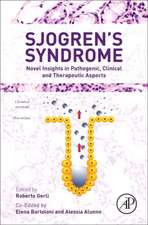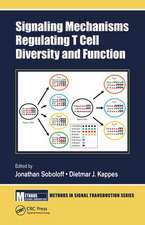Heat Shock Proteins in the Immune System
Editat de Robert J. Binder, Pramod K. Srivastavaen Limba Engleză Hardback – 17 apr 2018
| Toate formatele și edițiile | Preț | Express |
|---|---|---|
| Paperback (1) | 1088.77 lei 6-8 săpt. | |
| Springer International Publishing – 27 dec 2018 | 1088.77 lei 6-8 săpt. | |
| Hardback (1) | 1095.73 lei 6-8 săpt. | |
| Springer International Publishing – 17 apr 2018 | 1095.73 lei 6-8 săpt. |
Preț: 1095.73 lei
Preț vechi: 1153.39 lei
-5% Nou
Puncte Express: 1644
Preț estimativ în valută:
209.69€ • 227.70$ • 176.14£
209.69€ • 227.70$ • 176.14£
Carte tipărită la comandă
Livrare economică 22 aprilie-06 mai
Preluare comenzi: 021 569.72.76
Specificații
ISBN-13: 9783319690407
ISBN-10: 331969040X
Pagini: 272
Ilustrații: X, 185 p. 22 illus., 20 illus. in color.
Dimensiuni: 155 x 235 mm
Greutate: 0.45 kg
Ediția:1st ed. 2018
Editura: Springer International Publishing
Colecția Springer
Locul publicării:Cham, Switzerland
ISBN-10: 331969040X
Pagini: 272
Ilustrații: X, 185 p. 22 illus., 20 illus. in color.
Dimensiuni: 155 x 235 mm
Greutate: 0.45 kg
Ediția:1st ed. 2018
Editura: Springer International Publishing
Colecția Springer
Locul publicării:Cham, Switzerland
Cuprins
Introduction and history.- Part I: Structure of the HSPs in relation to chaperoning peptides and proteins.- Chapter 1: Hsp70-subsrate interactions.- Chapter 2: Molecular Chaperone Inhibitors.- Part II: Exposure of HSPs to immune cells.- Chapter 3: Extracellular Heat Shock Proteins as Stress Communication Signals.- Part III: Regulation of immune responses by extracellular HSPs.- Chapter 4: The Heat Shock Protein-CD91 pathway and Tumor Immuno-surveillance.- Chapter 5: Bridging the gaps in the vaccine development: Avant-garde vaccine approach with secreted heat shock protein gp96-Ig.- Chapter 6: Regulation of the Extracellular Matrix by Heat Shock Proteins and Molecular Chaperones.- Chapter 7: Heat shock protein mediated T cell responses in pathogen infections.- Chapter 8: An ancestral immune surveillance system in the amphibian Xenopus connecting certain heat shock proteins with classical and nonclassical MHC class I molecules.- Chapter 9: Inhibition of HSPs for Enhanced Immunity.
Notă biografică
Pramod K. Srivastava, Department of Immunology, University of Connecticut Health Center
Robert J. Binder, Department of Immunology, University of PittsburghTextul de pe ultima copertă
Experts from around the world review the current field of the immunobiology of heat shock proteins, and provide a comprehensive account of how these molecules are spearheading efforts in the understanding of various pathways of the immune system. This one-stop resource contains numerous images to both help illustrate the research on heat shock proteins, and better clarify the field for the non-expert. Heat shock proteins (HSPs) were discovered in 1962 and were quickly recognized for their role in protecting cells from stress. Twenty years later, the immunogenicity of a select few HSPs was described, and for the past 30 years, these findings have been applied to numerous branches of immunology, including tumor immunology and immunosurveillance, immunotherapy, etiology of autoimmunity, immunotherapy of infectious diseases, and expression of innate receptors. While HSPs can be used to manipulate immune responses by exogenous administration, they appear to be involved in initiation of de novo immune responses to cancer and likely in the maintenance of immune homeostasis.
Caracteristici
Comprehensive resource on the immunobiology of HSPs
One-stop resource on HSPs for both immunologists and cancer researchers
Numerous illustrations aid in clarifying HSPs to both experts and non-experts
One-stop resource on HSPs for both immunologists and cancer researchers
Numerous illustrations aid in clarifying HSPs to both experts and non-experts












